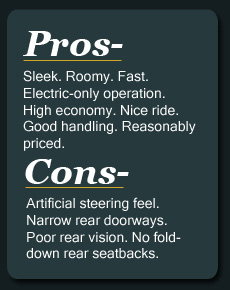2012 Kia Optima Hybrid
The
2012 mid-size Kia Optima Hybrid combines high style and practicality
with impressive fuel economy.
Price: $25,700
The 2012 Kia Optima Hybrid gas-electric sedan offers a good combination
of comfort, practicality, style, performance and high fuel economy.
The mid-size Optima Hybrid is rather large, as are many current
mid-size sedans, and its racy looking body has a roomy interior.
However, the coupe-like styling results in narrow rear door openings
and poor visibility through the rear window. (The optional rear camera
display thus is a good idea.) The small rear “lip”
spoiler is so nicely integrated into the styling that you have to look
twice to notice it. But too bad the gas/electric hybrid system prevents
use of dual exhausts with shiny outlet tips—always a nice
touch for a racy looking car.
Although the trunk is generally large, with a wide opening, the hybrid
system prevents rear seatbacks from flipping forward to allow more
cargo room.
This reasonably priced $25,700 front-drive Optima Hybrid is based on
the Hyundai Sonata, but the two cars share no exterior body panels. But
keep in mind that the low front end can be damaged by high curbs and
such.
A high beltline (where the body meets the side windows) prevented me
from driving with my elbow out the window at a comfortable angle. The
beltline also makes the rear seat feel somewhat low.
The 206-horsepower Optima Hybrid delivers an estimated 35 miles per
gallon in the city and 40 on highways. Go easy with the accelerator
pedal and the car will accelerate without using gas.
Other Optima models have regular gasoline-only engines. The hybrid
system in the Optima Hybrid works fairly seamlessly, but
isn’t among the best. It’s hooked to a responsive
six-speed automatic transmission with an easily used manual-shift
feature.
Performance is strong. Merging into fast freeway traffic and 65-80 mph
passing on highways are brisk.
The electric power steering is quick, but has an artificial feel. The
ride is supple, and handling is good—although not in the
sports-sedan class. The brakes stop the Optima Hybrid quickly and
surely, controlled by a pedal with a linear action.
Standard items include dual-zone automatic temperature control,
AM/FM/CD/MP3 audio system, cruise control, pushbutton start, adjustable
steering wheel with audio controls, keyless entry and power windows,
door locks and outside mirrors.
Options include the backup camera, navigation system, panoramic
sunroof, leather seat trim, upscale audio system and power folding
outside mirrors, along with larger (17-inch vs. 16-inch) tires with
alloy wheels.
Also optional are heated and cooled front seats and heated outboard
rear seats, heated steering wheel and power front driver and passenger
seats.
There are plenty of safety items. They include full-length side curtain
air bags, anti-lock brakes, hill-start assist and traction and
electronic stability controls. The large outside mirrors have
turn-signal indicators.
Backing up the car is a 10-year/100,000-mile limited powertrain
warranty and 5-year/60,000-mile limited basic warranty, along with a
roadside assistance program.
The quiet interior’s backlit gauges can be quickly read even
in bright sunlight, easily used controls and plenty of storage areas.
Cupholders are conveniently placed up front in the console and found in
the large fold-down rear center armrest. All doors have storage pockets
and beverage holders.
The trunk has old-style hinges, but the lined hood is held open by a
gas strut. Components in the crowded engine compartment look as if they
should be tackled only by a knowledgeable Kia mechanic.
Several folks said they initially thought my test jet-black Optima
Hybrid was a high-class German or Japanese sports sedan. They said it
should cost considerably more than it does.












